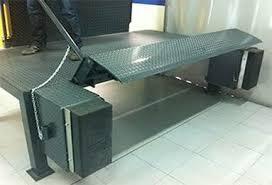High-capacity textile balers are essential tools in managing large volumes of textile waste and recycling materials efficiently. They play a critical role in the textile industry, especially in waste management and recycling operations. However, as the demand for textile recycling grows, balancing performance and safety in these powerful machines becomes increasingly crucial. This article explores the key considerations for achieving this balance, including the integration of mobile loading dock ramps to enhance operational efficiency and safety.
Understanding High-Capacity Textile Balers
High-capacity textile balers are designed to process large quantities of textiles, compressing them into compact bales for easier handling, storage, and transportation. These machines are equipped to handle various materials, including clothing, fabric scraps, and other textile waste. Their primary functions include:
- Compression: Compressing loose textiles into dense bales to reduce volume.
- Binding: Securing bales with ties or straps for stability during transport and storage.
- Discharge: Efficiently removing bales from the baler for further processing or shipping.
The effectiveness of a high-capacity textile baler is measured by its throughput, bale density, and operational efficiency. However, as with any industrial equipment, ensuring the safety of operators and maintenance personnel is equally important.
Key Performance Metrics
- Throughput: The amount of textile waste a baler can process per hour is a critical performance metric. High-capacity balers are designed to handle large volumes, but maintaining high throughput without compromising quality or safety is essential.
- Bale Density: The ability to compress textiles into tightly packed bales affects storage and transportation efficiency. High bale density reduces the volume of waste and maximizes space utilization.
- Operational Efficiency: The ease of use, maintenance requirements, and overall operational efficiency of a baler impact productivity. A well-designed baler should streamline operations while minimizing downtime.
Ensuring Safety in High-Capacity Textile Balers
- Safety Features: High-capacity textile balers should be equipped with advanced safety features, including:
- Emergency Stop Buttons: Easily accessible buttons that halt the machine in case of an emergency.
- Safety Guards and Shields: Protecting operators from moving parts and potential hazards.
- Automatic Locking Mechanisms: Preventing accidental opening of the baler during operation.
- Operator Training: Proper training for operators is crucial to ensure they understand how to use the baler safely and efficiently. Training should cover machine operation, emergency procedures, and maintenance protocols.
- Regular Maintenance: Routine maintenance checks are essential to prevent mechanical failures and ensure the baler operates safely. Regular inspections should include checking for worn parts, hydraulic system integrity, and proper calibration.
- Ergonomic Design: Balers should be designed to minimize physical strain on operators. Features like adjustable controls and accessible maintenance points can reduce the risk of injury.
Integrating Mobile Loading Dock Ramps
Mobile loading dock ramps play a significant role in optimizing the performance and safety of high-capacity textile balers. They facilitate the smooth loading and unloading of bales, improving operational efficiency and reducing safety risks. Here’s how mobile loading dock ramps contribute:
- Enhanced Accessibility: Mobile loading dock ramps provide easy access for loading textiles into the baler and unloading finished bales. They bridge the gap between ground level and the baler, ensuring a smooth and safe transfer of materials.
- Reduced Manual Handling: By using mobile loading dock ramps, operators can minimize manual handling, which reduces the risk of injury from lifting or maneuvering heavy loads. This also helps maintain a steady workflow and improves overall efficiency.
- Improved Safety: Mobile loading dock ramps are designed with safety features such as non-slip surfaces, guardrails, and locking mechanisms. These features prevent accidents and ensure that both operators and materials are secure during the loading and unloading process.
- Flexibility and Adaptability: Mobile loading dock ramps can be repositioned to accommodate different loading and unloading scenarios. This flexibility allows for efficient use of space and resources, adapting to the varying needs of high-capacity textile baler operations.
- Increased Efficiency: By streamlining the loading and unloading processes, mobile loading dock ramps can significantly increase the overall efficiency of textile baling operations. Faster material handling translates to higher throughput and better use of the baler’s capacity.
Balancing Performance and Safety
To achieve an optimal balance between performance and safety in high-capacity textile balers, consider the following strategies:
- Invest in Quality Equipment: High-quality balers with advanced safety features and robust performance metrics are essential. Investing in well-designed equipment ensures reliable operation and enhances safety.
- Implement Safety Protocols: Develop and enforce safety protocols for operating and maintaining the baler. Regularly review and update these protocols to address emerging risks and industry best practices.
- Integrate Efficient Handling Solutions: Use mobile loading dock ramps and other material handling equipment to streamline operations and reduce the physical demands on operators. This integration improves both performance and safety.
- Monitor and Analyze Performance: Continuously monitor the performance of the baler and the efficiency of the loading and unloading processes. Analyze data to identify areas for improvement and address any safety concerns promptly.
- Promote a Safety Culture: Foster a culture of safety within the organization by encouraging open communication, providing ongoing training, and recognizing safe practices. A strong safety culture helps prevent accidents and promotes a safer work environment.
Conclusion
Balancing performance and safety in high-capacity textile balers is crucial for optimizing operations and protecting personnel. By focusing on key performance metrics, implementing advanced safety features, and integrating mobile loading dock ramps, organizations can enhance both the efficiency and safety of their baling processes. Investing in quality equipment, enforcing safety protocols, and promoting a safety culture are essential steps in achieving this balance. As the demand for textile recycling continues to grow, maintaining a focus on performance and safety will ensure that high-capacity textile balers meet the needs of the industry while safeguarding those who operate them.
